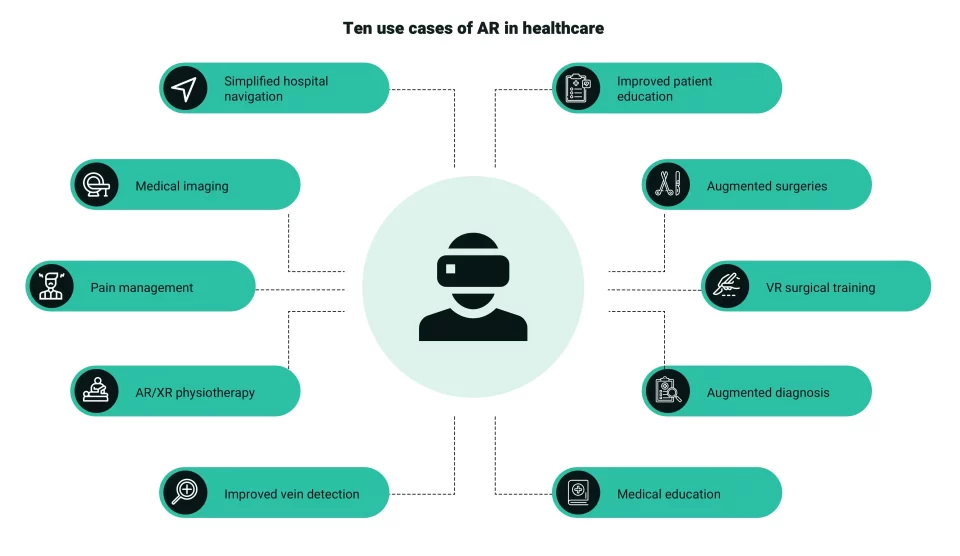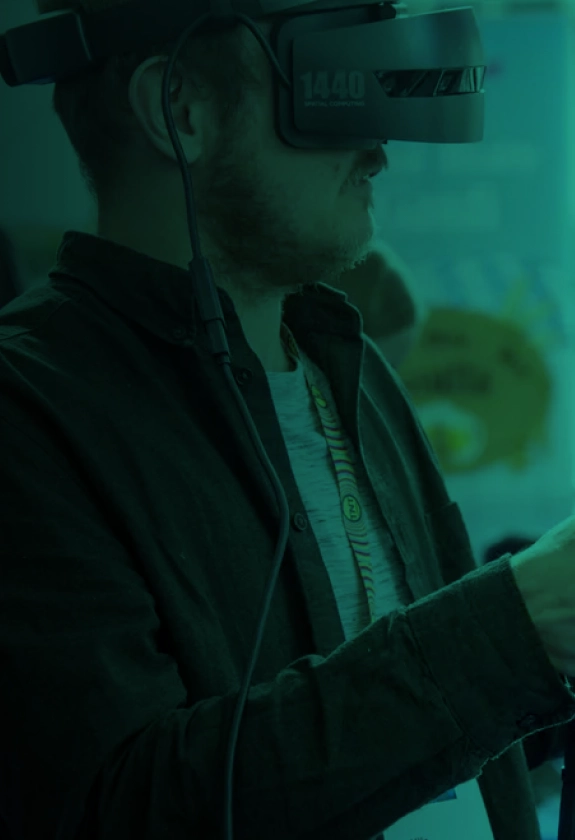INTRODUCTION
What is AR in healthcare?
Augmented reality (AR), virtual reality (VR), and extended reality (XR) healthcare software solutions are at the cutting edge of medical innovation. Augmented reality solutions create rich and interactive experiences that link patients to their providers, breaking down barriers to care in a profound new way. Boston Children’s Hospital, The Mayo Clinic, and the Cleveland Clinic are just a few of the elite hospital systems embracing augmented reality solutions to deliver better medical outcomes to their patients. The trend is catching up, and AR is spreading its wings in the healthcare sector as surgeons are being trained to conduct complicated laparoscopic and neurologic procedures with AR support to improve precision.
AR is created by superimposing digital elements over live images or videos.
The term augmented refers to enhancement.
Leading medical researchers believe augmented reality software and hardware integrations will transform healthcare delivery and usher in the next significant evolution of the modern healthcare industry.
The global extended reality healthcare market reached $2.7 billion in 2022 and is expected to be worth more than $9.7 billion within the next five years. Advances in robotics, data analytics, artificial intelligence, machine learning, and remote sensing technologies drive market growth.
The emerging metaverse of healthcare is being created as real-world and computer-generated content combines in real-time to deliver a mixed or extended reality environment. Augmented reality in healthcare promises the opportunity for medical professionals to understand what is happening in the body in real-time more precisely.
DEFINITIONS
Understanding the ‘reality’ concepts
Augmented reality is a way of creating a mixed reality (MR) or extended reality (XR). Greatly expanding the possibilities of medical innovation, researchers believe AR, MR, XR, and VR software and hardware solutions are healthcare’s next great frontier.
These solutions are being developed in every area of medical practice, from laboratories to operating theaters through emergency care centers to remote patient monitoring tools.
What is AR?
Augmented reality transforms an image or video by projecting digital content on top of the footage. MR is another term used to describe augmented reality. AR and MR may be used interchangeably.
What Is VR?
Virtual reality uses computer-generated, enhanced, and modified images and video to create a simulated environment.
What is XR?
Extended reality is a blanket term for AR/MR and VR/MR applications. XR may be used interchangeably with AR, VR/MR.
What’s the difference between AR, MR, and VR?
VR vs MR - MR is based on real-world environments, while VR is simulated/computer-generated.
VR vs AR - AR is accessible via smartphones and tablets, and VR requires a headset device.
APPLICATIONS
Augmented reality applications for healthcare
Augmented reality solutions are being used innovatively to both enhance the medical professionals’ expertise and enrich patient experience.
As part of a healthcare technology strategy, these solutions extend the reach of physicians and improve their diagnostic abilities by providing data-driven insights that invigorate every level of medical practice. In just a few short years, extended reality software and hardware will lead in delivering the end-to-end digital health ecosystem.
AR technologies are foundational in improving medical training, organizational compliance, the automated implementation of medical best practices, and applying corrective procedures at the first sign.
At the forefront of the data revolution invigorating so many industries, healthcare has much to gain from the more widespread adoption of augmented reality software and hardware solutions.
Here’s a look at some of the most impressive augmented reality use cases driving medical device innovation in 2023.
USE CASES
2023 Healthcare trends in AR
Augmented reality use cases continue to expand all over the healthcare landscape. Advanced imaging, sensing, and diagnostic capabilities are combined to deliver new standards of medical care.
Extended reality solutions are transforming medical practice by providing clinical teams with new ways to interpret diagnostic resources, map the human body, and drive more efficient medical decision-making.
Robotic-assisted surgery
Augmented reality drives intraoperative robotic-assisted surgical headsets
One of the most exciting areas for augmented reality innovation in healthcare is robotic-assisted surgery tools. In this practice application, surgeons leverage AR to enhance their ability to direct robotic surgical instruments, reducing the possibility of injuring the patient and driving better medical outcomes by increasing the efficiency of surgical precision.
Emerging applications of AR technologies in surgical settings include preoperative systems for surgical planning and patient-specific rehearsal, intraoperative systems for navigating complex procedures and easing the visualization of preoperative/perioperative patient data, and simulation systems for surgical training.
Shortly, AR/XR technologies will continue to extend human capabilities to deliver more effective life-saving surgical interventions.
Hospital navigation
Virtual hospital navigation, AR for smart localization, and mobile wayfinding
Many healthcare facilities are extensive and sprawling campuses that are complex and challenging to navigate. A straightforward way that augmented reality is improving is through digital tools to improve wayfinding.
Evidence-based research continues to validate the benefits of AR-enhanced wayfinding tools to increase patient satisfaction by making complex medical facilities easier for patients to navigate.
Brilliant localization and mobile wayfinding are state-of-the-art capabilities unlocked when healthcare software development companies build augmented reality solutions and integrate them with modern mobile device technologies.
Physical therapy
Gamified solutions leverage AR/XR to drive patient engagement
One of the most exciting healthcare AR use cases of 2023 is the rise of gamification as a tool to drive patient engagement. Physical therapy digital health applications leveraging augmented reality are helping patients stay more engaged with their care plans.
Their form (gait, mortar movements, posture) is corrected while completing their physical therapy care routine using mobile devices, cameras, and sensing technologies. Gamification-driven AR delivers a more engaging and fun opportunity for completing home-based therapy: points for taking pills on time, award of a badge for following the correct diet, etc.,
Augmented reality helps to create a more seamless and realistic digital experience that promotes better adherence to medical guidelines and outcomes.
 The applications of AR in healthcare are increasing impacting medical education and training too
The applications of AR in healthcare are increasing impacting medical education and training too
Use-cases of AR in healthcare
Preparing the next generation of medical leaders
One of the most impressive areas where AR software is making a huge impact is the area of education. Medical students, researchers, practicing physicians, and hospital administrators can all benefit tremendously from the 3D visualizations, Google Glass, avatars, mixed reality, and holograms that provide a new way of interpreting medical data and visualizing the human body.
Medical education - University medical centers use AR solutions to provide students with advanced ultra-realistic HD images of the physical exterior and internal anatomy.
Medical training - AR software delivered via tablets allows practitioners to practice responding to simulations of different patient scenarios to improve social, technical, and team-based skills.
AR as an assistive tool for surgeons - A surgeon wearing an AR headset is able to view mission-critical patient vital signs such as heart rate, body temperature, blood pressure, and breathing rate, as well as CT, MRI, and three-dimensional ultrasound (DUS) scan data. AR tools provide medical teams with the information they need to make faster decisions at a lower cost, leading to better medical outcomes.
Medical imaging - AR, as part of a digital healthcare ecosystem, delivers enhanced visualization of medical imaging data by superimposing stereoscopic projections over a surgical procedure. The data collected allows the surgeon to be more precise. Increased efficiency leads to better outcomes for patients, providers, and patients.
AR for enhanced vein detection capabilities - AR-enhanced visualizations vastly enhance physicians’ ability to detect veins, sparing patients from traumatizing and painful moments. All over the medical practice landscape, AR solutions improve care by allowing practitioners to do their core jobs more quickly and efficiently. Laser-guided medical procedures matched with HD anatomical visualizations help doctors to be more precise in everything they do.
Empowering patient-centered care - As augmented reality solutions proliferate, adoption will happen on both the provider side and through patient-facing digital health apps. Shortly, the visual overlays of AR-enhanced software integration will vastly enhance patient visits. Providers can share information directly with patients in a new way that will ultimately remove barriers to care and invigorate patients to take a more active role in guiding their health.
AR as a patient care tool - Researchers have developed tools for evaluating patient behaviors to establish policies and guidelines that better match person-focused care expectations.
FINAL THOUGHTS
AR-VR as part of the digital health ecosystem
While augmented reality and virtual reality adoption may very well be in their infancy, it should be no surprise that America’s most prestigious medical facilities have already invested heavily in driving the innovation needed to make these novel technologies more accessible.
In the coming years, you can leverage AR through custom healthcare software product development services.






